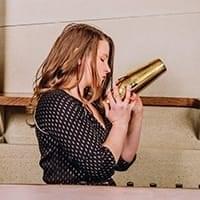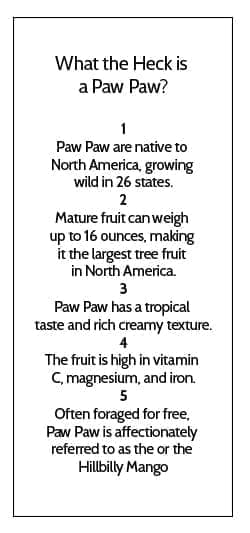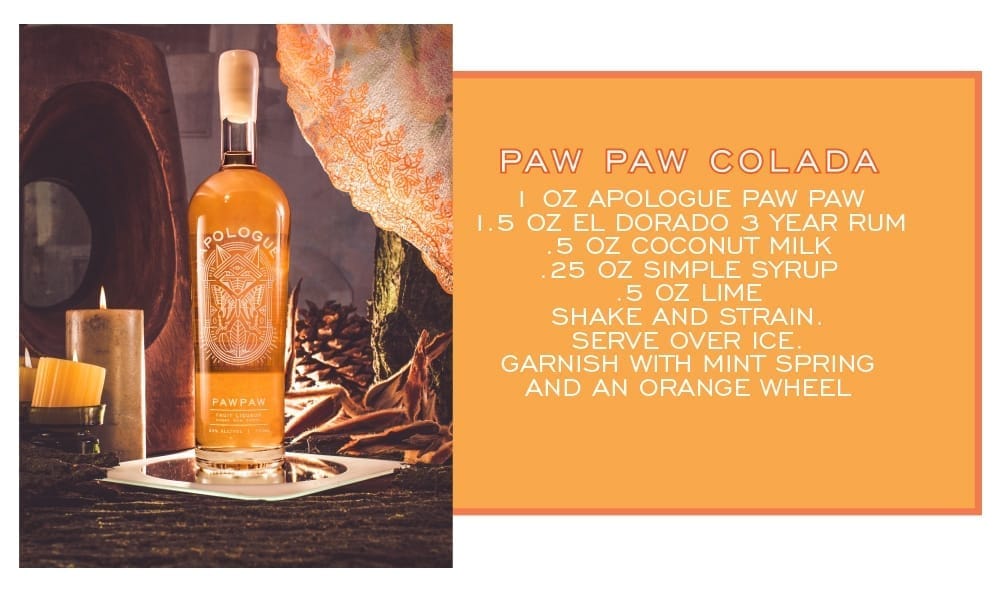Meet the Maker: Julia McKinley X Apologue Paw Paw
When deciding on our first seasonal release, we knew we wanted to do something different, something collaborative, and something that would continue to elevate the liqueur category.
We first had the Paw Paw from Oriana’s Orchards at a local farmer’s market, and we were floored to learn this tropical tasting fruit was native to the Midwest. A delectable mix of mango and banana, the Paw Paw has been limited commercially by its short shelf-life, so we were excited to encapsulate its amazing flavor in liqueur form. To bring in a fresh perspective, we hooked up with Julia McKinley, a veteran of tiki-temple Lost Lake, with a passion for elevating classic cocktails. She’s currently gearing up for a new project called Young American in Logan Square opening this fall!
Robby Haynes (RH): Can you tell us a little bit about your background? How you started working in “the industry” and what that was like.

Julia Mckinley (JM): Like you said, I hail from North Carolina. I really couldn’t get out of there fast enough and at 18 I moved to Massachusetts for college. After graduation, I landed in Austin, TX. This was back in 2010 and I started working at a small classic cocktail bar called The Good Knight. I was 22 and it was great to get such an early introduction to classic cocktails. I was serving and while I was learning a lot, I was desperate to get behind the bar. It certainly wasn’t a welcoming environment. Most of the “serious” bartenders in the city at the time were men, in their late 20s to early 30s, in suspenders, bow ties and all that cheesy garb. No one was interested in training me, so I started doing a lot of reading and obsessively watching bartenders.
RH: And eventually you made it back behind the bar…
JM: I was working at a popular lunch place downtown called Annie’s, and the GM needed a bartender because they had decided to open for brunch last minute on July 4th. I lied and said I had bartending experience, and he reluctantly agreed to put me behind the bar. After that, I had a regular brunch shift, and there was no turning back.
RH: Haha. There really is no turning back! When I started bartending I thought I’d do it for a year or two, make a little cash and get a “normal” job. Which a lot of people do. Some folks, however, push on through to the other side. Did you see bartending as a career when you first started?
JM: At the time, I wouldn’t say that it was what I wanted to be doing, not because of the work so much as the hospitality environment in Austin at the time was very unprofessional. My female co-workers and I were regularly being harrassed and dismissed by managers.
I was discouraged from bartending because I “couldn’t lift a keg” or “reach high bottles on the back bar”. I will never forget being told those things and how frustrating it felt, but at the time it was just something I had to deal with. So initially I never saw how I could make this a career, nevermind the lack of benefits or the variability of income.
RH: That kind of attitude is toxic and is still pretty prevalent. I feel like there are a lot of people fighting the good fight here in Chicago and that things are slowly getting better. Kind of crazy that you would start there and wind up a few years later at a place like Lost Lake, which is widely known for actively empowering and supporting their employees. How’d that happen?
JM: I moved to Chicago in early August 2013. I was lucky enough to land a job at Three Dots and A Dash. It was truly a right place right time kind of thing. They really needed bartenders and I walked in off the street with a bar manager job on my resume. Training for that job was the first time I had ever been critiqued on technique, and it was Paul McGee doing the critiquing. It was initially very intimidating, but he turned out to be a very kind mentor. A little over a year in, Paul announced he was leaving Three Dots, and he asked me to come over to Lost Lake. It was a real bonding experience between the opening bartenders; we really felt like we were building the bar that we wanted to work at. This is also when I first started working with Shelby Allison and truly understood her contribution to the cocktail menu, as a designer and consultant. We put so much of ourselves into that bar. It will always mean a lot to me and it is still my favorite bar in Chicago.
RH: I’m assuming there’s quite a bit of education involved in any high quality Tiki program. What kind of things did you learn there (for ex. appreciation of certain spirits, specific techniques or ways of thinking about cocktail builds, importance of garnish etc…)
JM: Tiki is unique. It can be punishingly ornate and complicated, so the approach to making palatable tiki cocktails is really tough. Fundamentally, these cocktails are complex and should be layered, not muddy. Working with Paul and Shelby, who had so much experience with constructing these very difficult cocktails, has forever shaped how I approach a new drink. Working at Three Dots and a Dash really allowed me to explore and fall in love with rum and that only grew at Lost Lake. We had weekly classes on the rum selection, cocktails and the like, and I became very passionate about it. Rum will always be my favorite thing to work with.
RH: And from there you went to Milk Room for a little while. The cocktails themselves there are stylistically very different from the ones y’all were making at Lost Lake. Working with fewer ingredients, did you find those drinks more or less challenging to nail? Was there the added pressure of using rare/allocated spirits as the base?
JM: I was at Milk Room just shy of two years. There is nothing like that bar, it was a really amazing experience to work with super rare spirits. The cocktail recipes are far more simplistic, which has its benefits and its complications. Classic cocktails are a harmony of very few most challenging for many bartenders. For us, the ingredients we were working with presented the greatest challenge because we couldn’t continue to use product for countless versions. If we didn’t nail a cocktail in the first three or so tries we had to table it for another day. We were a really tight team - Julia Gordon, Stephen Andrews, Paul and I - and we had a great dynamic in working with these ingredients and making exceptional cocktails.
RH: Both Milk Room and LL have clearly defined cocktail styles. How would you describe your own style?
Making Milk Room cocktails definitely appeals more to the way that I like to drink. I feel like working on those menus was formative in establishing my own tastes. I like to start with a classic cocktail format but am not afraid to complicate things a little bit. I still love working with tropical fruit flavors and having a subtle hand with those can really elevate a drink. I’m always wary of defining my style, as I hope it will continue to evolve.
RH: Cool. We are thrilled to collaborate with you on the Paw Paw Liqueur and are really psyched on how this turned out. I certainly had never eaten or a Paw Paw taste like to you? Does it remind you of anything else? What were your initial impressions of the fruit itself?

JM: No, I had never had one before. I first tasted the pulp and later had a fresh Paw Paw, which was really inspiring. The flavor of the fruit is subtle, but there are distinct tropical notes, like the tanginess of a slightly under-ripe banana or the bite of a mango. I have heard it referred to as the Indiana Banana, and I think that is especially true in the texture. It has a warm baking spice quality that complements the subtly bitter taste in the fruit. The Paw Paw is certainly unique.
RH: Can you walk us through your creative process? Once you started thinking about it, how’d you decide on what ingredients and flavors to pair with it?
JM: When y’all first asked me to collaborate on the Paw Paw liqueur, I did some research to get a feel for its main flavors. Before I had even tasted the fruit I had landed on using lime peel and vanilla. When I finally got to taste the pulp, and later when I got a whole fresh fruit, I was delighted by the custardy texture and wanted our final product to have a really satisfying mouth feel. This encouraged me to use a little licorice root. I also really wanted a lingering baking spice in the finish to compliment the tropical notes. I remember we played around with a clove for a while before settling on ginger and cinnamon. Ginger is by far my favorite baking spice, and I think it is a great supporting ingredient for Paw Paw. Later in the process, I starting thinking about Granny Smith apples. Those add a lovely brightness and aroma, helping tie the whole thing together.
RH: For the folks reading this right now can you give a little guidance on how to use it? What is a good starting point for pairing?
JM: The Paw Paw is an ideal fall ingredient, like (and please forgive me for saying this) an elevated pumpkin spice. It has some very indulgent flavors with notes of vanilla and slight anise. It pairs well with dark spirits like bourbon or cognac, and of course, I’m delighted with how it tastes with rum. With most cocktails I have used it as a base and allowed other spirits, citrus, etc. to elevate and enhance its flavors. One of my favorites was the Paw Paw Colada with Rum, Coconut Cream, Lime and Paw Paw. Totally different, but the Hot Toddy with Paw Paw, Bourbon, Honey and Lemon was extraordinary too.
